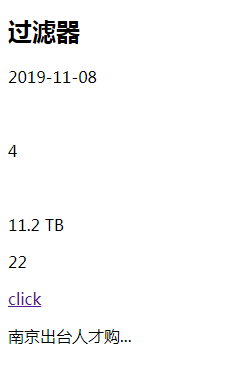django的模版
django的模版
1模版语法
views.py 书写方式
def index(request): ''' 模版语法分: 变量: {{ }} 1. 深度查询 句点符 2. 过滤器 {{val|filter_name:参数}} 标签: {% %} ''' name = "augustyang" test_list = [11,22,33,44] class people: def __init__(self,name,age): self.name = name self.age = age p1 = people("yy",18) p2 = people("ss",28) people_list = [p1,p2] # return render(request, "index.html",{"name":name}) return render(request, "index.html",locals())

''' 用到的知识有: 引用方式: {"name":name} 指定引用 locals() 相当于全部引用 render(request, "index.html",{"name":name,"p1":p1}) index.html 文件 调用方式 1. 深度查询 句点符 <p> {{ name }}</p> <p> {{ p1 }}</p> <p> {{ p1.name }}</p> <p> {{ test_list.1 }}</p> <p> {{ people_list.1.name }}</p> '''
index.html 书写方式
<p> {{ name }}</p> <p> {{ p1 }}</p> <p> {{ p1.name }}</p> <p> {{ test_list.1 }}</p> <p> {{ people_list.1.name }}</p>
2过滤器
views.py 书写方式
def index(request): ysl = 22# 过滤器 import datetime now = datetime.datetime.now() file_size = 12343242123123 content = "南京出台人才购房新政,全市所有在售房源向海内外人才全开放,并为人才购房开辟优先通道,该政策将于2020年1月1日起施行。据中新经纬客户端不完全统计" link = "<a href=''>click</a>" return render(request, "index.html",locals())
index.html 书写方式
<!-- 过滤器 --> <h2>过滤器</h2> <!-- date --> <p>{{ now|date:"Y-m-d " }}</p> <!-- length 返回列表和字符串长度--> <p>{{ test_list|length }}</p> <!-- filesizeformat 11.2 TB--> <p>{{ file_size|filesizeformat }}</p> <!-- default 为空使用默认值 否则使用变量值--> <p>{{ ysl|default:"没有这个值" }}</p> <!-- default 为空使用默认值 否则使用变量值--> <p>{{ link|safe }}</p> <!-- 要截断的字符数 --> <p>{{ content|truncatechars:10 }}</p>

3标签
标签 有for循环 if 循环 with as 重命名
①for标签
{% for foo in test_list %} <p>{{ foo }}</p> {% endfor test_list%} {% for foo in people_list %} <p>{{ foo.name }}</p> {% endfor people_list %} <!-- 字典遍历--> {% for key,val in dic.items %} <p>{{ key }}:{{ val }}</p> {% endfor %} {% for key in dic %} <p>{{ key }}</p> {% endfor %} {% for people in people_list %} <p>{{ people }}</p> {% endfor %}
②if 标签
{% if user %} <p> <a href="">hi {{ user }}</a> <a href="">注销</a> </p> {% else %} <p> <a href=" ">登录</a> <a href=" ">注册</a> </p> {% endif %}
③with标签
{% with people_list.1.name as n %} <p>{{ n }}</p> <p>{{ n }}</p> {% endwith %}
④ csrf_token
在form表单点击提交按钮后,会出现Forbidden:CSRF verification failed. Request aborted,解决方法两种
方法一:在settings.py中注释掉 'django.middleware.csrf.CsrfViewMiddleware',
方法二:在form表单中 添加这个模板语言
<!DOCTYPE html> <html lang="en"> <head> <meta charset="UTF-8"> <title>Title</title> </head> <body> <form method="post" action=""> name: <input type="text" name="user" > <input type="submit" name=""> {% csrf_token %} </form> </body> </html>
4自定义标签和过滤器
前提
1 在APP中新建一个包 templatetags 必须是这个名字
2 新建一个py文件 my_tag_filter.py
3.在my_tag_filter.py 文件中
from django import template register=template.Library() @register.filter def multi_fliter(x,y): return x*y @register.simple_tag def multi_tag(x,y): return x*y
2. 使用
<h2>自定义标签和过滤器</h2> {% load my_tag_filter %} <p>{{ ysl|multi_fliter:20 }}</p> <p>{% multi_tag 7 8 %}</p> {% if ysl|multi_fliter:22 > 100 %} <p>100</p> {% else %} <p>{{ ysl }}</p> {% endif %} {#{% if multi_tag ysl 20 >100 %}#} {#<p>100</p>#} {#{% else %}#} {#<p>{{ ysl }}</p>#} {#{% endif %}#} <!-- filter可以用在if等语句,simple_tag不可以 -->
需要先引用
{% load my_tag_filter %}
filter可以用在if等语句,simple_tag不可以
5模版继承
1引用bootstrap,jquery
①在工程下新建一个包 一般叫static

②配置路径
# static 是静态文件的别名 STATIC_URL = '/static/' # 配置 静态文件 STATICFILES_DIRS=[ os.path.join(BASE_DIR,"static"), ]
③重启 django 加载配置
<link rel="stylesheet" type="text/css" href="/static/bootstrap-3.3.7/css/bootstrap.css"> <script type="text/javascript" src="/static/jquery-3.4.1.js"></script>
2. 模版继承样例
advertise.html
<div class="panel panel-danger"> <div class="panel-heading">Panel heading without title</div> <div class="panel-body"> 11111 </div> </div> <div class="panel panel-success"> <div class="panel-heading">Panel heading without title</div> <div class="panel-body"> 3333 </div> </div> <div class="panel panel-info"> <div class="panel-heading">Panel heading without title</div> <div class="panel-body"> 555555 </div> </div>
base.html
<!DOCTYPE html> <html lang="en"> <head> <meta charset="UTF-8"> <!-- 标题模版--> {% block title %} <title>base</title> {% endblock %} <link rel="stylesheet" type="text/css" href="/static/bootstrap-3.3.7/css/bootstrap.css"> <style> .header { width: 100%; height: 50px; background-color: #369; } </style> <script type="text/javascript" src="/static/jquery-3.4.1.js"></script> </head> <body> <div class="header"></div> <div class="container"> <div class="row" style="margin-top: 50px;"> <div class="col-lg-4 col-mg-4"> <!-- 继承 另一个模版 --> {% include 'advertise.html' %} </div> <div class="col-lg-8 col-mg-8"> <!-- 内容模版 自己改写 --> {% block con %} <h4>content</h4> {% endblock %} </div> </div> </div> </body> </html>
auth.html
{% extends 'base.html' %} {% block title %} <title>auth</title> {% endblock %} {% block con %} {#{{ block.super }}#} <h4>login</h4> <h4>login</h4> {% endblock con%}
index.html

{% extends "base.html" %} {% block title %} <title>index</title> {% endblock %} {% block con %} {# <p> {{ name }}</p>#} {# <p> {{ p1 }}</p>#} {# <p> {{ p1.name }}</p>#} {# <p> {{ test_list.1 }}</p>#} {# <p> {{ people_list.1.name }}</p>#} <!-- 过滤器 --> <h2>过滤器</h2> <!-- date --> <p>{{ now|date:"Y-m-d " }}</p> <!-- length 返回列表和字符串长度--> <p>{{ test_list|length }}</p> <!-- filesizeformat 11.2 TB--> <p>{{ file_size|filesizeformat }}</p> <!-- default 为空使用默认值 否则使用变量值--> <p>{{ ysl|default:"没有这个值" }}</p> <!-- default 为空使用默认值 否则使用变量值--> <p>{{ link|safe }}</p> <!-- 要截断的字符数 --> <p>{{ content|truncatechars:10 }}</p> <!-- 标签 --> <h2>标签</h2> {% for foo in test_list %} <p>{{ foo }}</p> {% endfor test_list%} {% for foo in people_list %} <p>{{ foo.name }}</p> {% endfor people_list %} <!-- 字典遍历--> {% for key,val in dic.items %} <p>{{ key }}:{{ val }}</p> {% endfor %} {% for key in dic %} <p>{{ key }}</p> {% endfor %} {% for people in people_list %} <p>{{ people }}</p> {% endfor %} <hr> {% if user %} <p> <a href="">hi {{ user }}</a> <a href="">注销</a> </p> {% else %} <p> <a href=" ">登录</a> <a href=" ">注册</a> </p> {% endif %} {% with people_list.1.name as n %} <p>{{ n }}</p> <p>{{ n }}</p> {% endwith %} <hr> <h2>自定义标签和过滤器</h2> {% load my_tag_filter %} <p>{{ ysl|multi_fliter:20 }}</p> <p>{% multi_tag 7 8 %}</p> {% if ysl|multi_fliter:22 > 100 %} <p>100</p> {% else %} <p>{{ ysl }}</p> {% endif %} {#{% if multi_tag ysl 20 >100 %}#} {#<p>100</p>#} {#{% else %}#} {#<p>{{ ysl }}</p>#} {#{% endif %}#} <!-- filter可以用在if等语句,simple_tag不可以 --> {% endblock %}
需要注意项:
1 如果你在模版中使用 {% extends %} 标签,它必须是模版中的第一个标签。其他的任何情况下,模版继承都将无法工作。
2 在base模版中设置越多的 {% block %} 标签越好。请记住,子模版不必定义全部父模版中的blocks,所以,你可以在大多数blocks中填充合理的默认内容,然后,只定义你需要的那一个。多一点钩子总比少一点好。
3 如果你发现你自己在大量的模版中复制内容,那可能意味着你应该把内容移动到父模版中的一个 {% block %} 中。
4 为了更好的可读性,你也可以给你的 {% endblock %} 标签一个 名字 。例如:
{% block content %}
...
{% endblock content %}
posted on 2019-11-08 14:58 augustyang 阅读(142) 评论(0) 编辑 收藏 举报


